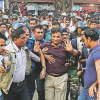DSCC to install early warning sensors
Dhaka South City Corporation (DSCC) has decided to install five earthquake sensors at the edges of Dhaka city so that utility service providers could get 10 to 15 seconds early warnings.
Gas, electricity, water, and sewerage lines would be damaged immensely during the earthquake and the number of casualties would be high due to fires, which rescuers would most likely be unable to reach and put out, said experts.
“We will set up the sensors under a World Bank-funded Urban Resilience Project,” said Mayor Sayeed Khokon, who chaired the first meeting of City Corporation Disaster Management Committee held at the Nagar Bhaban.
Thirty-nine government organisations and ward councillors took part in the meeting.
The mayor requested the utility service providers like Dhaka Wasa, Dhaka Power Distribution Company Ltd, and Titas Gas Transmission and Distribution Company Ltd, to take necessary steps to set up the sensors so that the connections of gas, electricity and water could be shut down automatically in the event of an earthquake.
“It will take around Tk 1 crore to set up the sensors at five points on the edges of Dhaka 20 to 30 metres underground,” said Prof Mehedi Ahmed Ansary of the department of civil engineering of Buet.
He said to get proper benefit of the sensors, setting up Spectral Intensity (SI) sensors at different points of the networks of service providing lines was necessary.
City corporations and other service providers need to work together to set up the sensors, he said.
This kind of sensors is used in Japan, Mexico, and the USA, Ansary said.
During surgeries in operation theatres of Japanese hospitals, doctors could take some necessary emergency steps following the early warnings of earthquakes, said Mohammad Abu Sadeque, director of Housing and Building Research Institute.
Quoting a 2010 survey done by the Comprehensive Disaster Management Programme, Prof ASM Maksud Kamal, chairman of the department of disaster science and management of Dhaka University, told The Daily Star that Dhaka has 1,834km of gas transmission pipes and there would be leaks in 56 places and cracks would develop in 191 places.
There were 1,118km of underground water pipes in the city and if the Madhupur fault had an earthquake of 7.5 magnitude, pipes would leak in 79 points and break in 272 places, he said.
In the 630km of sewerage network, there would be leaks in 107 places and cracks in 360 points, the professor said.
Overhead electricity poles and snapping of cables would be a major problem too. At least 16,000 electricity poles out of 56,000 in Dhaka would topple during the tremor, he said.
Prof Mehedi said 35 percent area of Dhaka city corporations and 60 percent area of Rajdhani Unnayan Kartripakkha were vulnerable to the risks of utility network-related hazards in the event of an earthquake.
He suggested that the quality of soil be improved to reduce the possible damage to utility networks and buildings.
“Soil can be improved by injecting cement water mixture under very high pressure, which is commercially called 'jet grouting'. This method of soil improvement is suitable for loose sand and clay,” said Ansary.
Mayor Khokon in the meeting also requested Rajuk to prepare a list of vulnerable buildings and demolish them immediately.
He also decided to make a first responders committee in each ward under DSCC, comprising 200 members and train them.

 For all latest news, follow The Daily Star's Google News channel.
For all latest news, follow The Daily Star's Google News channel. 








Comments